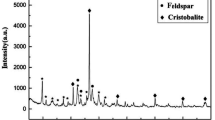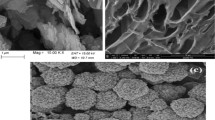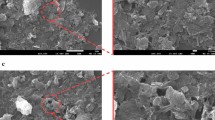Abstract
It is reported an innovative though still exploratory study devoted to characterizing their structure and evaluating the response of zeolite-magnetite composites as adsorbing materials to remove Hg2+ from water. The zeolite material collected from a sampling site in Parral, Chile, was identified and structurally characterized as containing mordenite with crystallographic orthorhombic unit cell dimensions a = 18.060(1) Å; b = 20.429(2) Å and c = 7.5091(7) Å. From Mössbauer data, two paramagnetic ferric iron sites occur in its structure. This zeolite, a sample of synthetic magnetite and their two-component composites were used as adsorbers to sequester Hg2+ dissolved in water. The adsorption rate was found to reach a steady state of nearly constant Hg concentrations corresponding to 26.2; 22.1; 20.6; 17.4 and 16.7 mg Hg per g adsorber, between 24 h and 72 h reaction, for the samples zeolite only, for the composites zeolite:magnetite mass ratio 10:1; 5:1; 1:1 and for the magnetite only, respectively. These corresponding maximum adsorption capacities reduced the initial concentration of Hg2+ in water from 700 mg L−1 to an equilibrium concentration of 0; 110; 150; 240 and 250 mg L−1, respectively. Although the composites showed a lower adsorption capacity of Hg than did the sole zeolite (zeol sample), the composites contained magnetic particles, which allow the adsorbing systems to be readily removed from the aqueous medium, with a magnetic field. These combined characteristic point to the remarkable potential of such materials, particularly the mag-zeol-2, to be used to remediate natural bodies of water contaminated with Hg.
Similar content being viewed by others
References
Campos, M.L.A.M., Bendo, A., Viel, F.C.: Métodos de baixo custo para purificação de reagentes e controle da contaminação para a determinação de metais traços em águas naturais. Quim Nova. 25(5), 808–813 (2002). https://doi.org/10.1590/S0100-40422002000500017
Windmöller, C.C., Santos, R.C., Athayde, M., Palmieri, H.E.L.: Distribuição e especiação de mercúrio em sedimentos de áreas de garimpo de ouro do Quadrilátero Ferrífero (MG). Quim Nova. 30(5), 1088–1094 (2007). https://doi.org/10.1590/S0100-40422007000500007
Lacerda, L.D., Salomons, W.: Mercury Form Gold and Silver Mining: a Chemical Time Bomb? Springer, Berlin (1998)
Hacon, S., Artaxo, P., Gerab, F., Yamasoe, M.A., Campos, R.C., Conti, L.F., de Lacerda, L.D.: Atmospheric mercury and trace elements in the region of Alta Floresta in the Amazon Basin. Water, Air, and Soil Pollut. 80(1–4), 273–283 (1995). https://doi.org/10.1007/BF01189677
Klingerman, D.C., La Rovere, E.L., Costa, M.A.: Management challenges on small-scale gold mining activities in Brazil. Environ. Res. 87(3), 181–198 (2001). https://doi.org/10.1006/enrs.2001.4301
Nriagu, J.: Mercury pollution from the past mining of gold and silver in America. The Sci. Total Environ. 149, 167–181 (1994). https://doi.org/10.1016/0048-9697(94)90177-5
Lacerda, L.D.: Global mercury emissions from gold and silver mining. Water, Air, and Soil Pollut. 97(3–4), 209–221 (1997). doi: https://doi.org/10.1023/A:1018372505344
Slowey, A.J., Rytuba, J.J., Brown, G.E.: Speciation of mercury and mode of transport from placer gold mine tailings. Environ. Sci. Technol. 39(6), 1547–1554 (2005). https://doi.org/10.1021/es049113z
Barron-Zambrano, J., Laborie, S., Vier, P., Rakib, M., Durand, G.: Mercury removal from aqueous solutions by complexation–ultrafiltration. Desalination. 144(1–3), 201–206 (2002). https://doi.org/10.1016/S0011-9164(02)00312-0
Hernandez-Ramirez, O., Holmes, S.M.: Novel and modified materials for wastewater treatment applications. J. Mater. Chem. 18, 2751–2761 (2008). https://doi.org/10.1039/B716941H
Lopes, C.B., Otero, M., Coimbra, J., Pereira, E., Rocha, J., Lin, Z., Duarte, A.: Removal of low concentration Hg2+ from natural waters by microporous and layered titanosilicates. Microporous Mesoporous Mater. 103(1–3), 325–332 (2007). https://doi.org/10.1016/j.micromeso.2007.02.025
Lopes, C.B., Lito, P.F., Otero, M., Lin, Z., Rocha, J., Silva, C.M., Pereira, E., Duarte, A.C.: Mercury removal with titanosilicate ETS-4: batch experiments and modelling. Microporous Mesoporous Mater. 115(1–2), 98–105 (2008). https://doi.org/10.1016/j.micromeso.2007.10.055
Ferreira, T.R., Lopes, C.B., Lito, P.F., Otero, M., Lin, Z., Rocha, J., Pereira, E., Silva, C.M., Duarte, A.: Cadmium(II) removal from aqueous solution using microporous titanosilicate ETS-4. Chem. Eng. J. 147(2–3), 173–179 (2009). https://doi.org/10.1016/j.cej.2008.06.032
Theron, J., Walker, J.A., Cloete, T.E.: Nanotechnology and water treatment: applications and emerging opportunities. Crit. Rev. Microbiol. 34(1), 43–69 (2008). https://doi.org/10.1080/10408410701710442
Miretzky, P., Cirelli, A.F.: Hg(II) removal from water by chitosan and chitosan derivatives: a review. J. Hazard. Mater. 167(1–3), 10–23 (2009). https://doi.org/10.1016/j.jhazmat.2009.01.060
Hakami, H., Zhang, Y., Banks, C.J.: Thiol-functionalised mesoporous silica-coated magnetite nanoparticles for high efficiency removal and recovery of Hg from water. Water Res. 46(12), 3913–3922 (2012). https://doi.org/10.1016/j.watres.2012.04.032
Jackson, M.L.: Soil chemical analysis: advanced course, 3rd edition. Published by the author, Madison, Wisconsin, USA, p. In: 894 (1969)
Andrade, A.L., Souza, D.M., Pereira, M.C., Fabris, J.D., Domingues, R.Z.: Magnetic properties of nanoparticles obtained by different chemical routes. J. Nanosci. Nanotechnol. 9(3), 2081–2087 (2009). https://doi.org/10.1166/jnn.2009.423
Andrade, A.L., Valente, M.A., Ferreira, J.M.F.F., Fabris, J.D.: Preparation of size-controlled nanoparticles of magnetite. J. Magn. Magn. Mater. 324(10), 1753–1757 (2012). https://doi.org/10.1016/j.jmmm.2011.12.033
Andrade, A.L., Souza, D.M., Pereira, M.C., Fabris, J.D., Domingues, R.Z.: pH effect on the synthesis of magnetite nanoparticles by the chemical reduction-precipitation method. Quim Nova. 33(3), 524–527 (2010). https://doi.org/10.1590/S0100-40422010000300006
Roque-Malherbe, R., Diaz-Aguila, C., Reguera-Ruiz, E., Fundora-Lliteras, J., López-Colado, L., Hernández-Vélez, M.: The state of iron in natural zeolites: a Mössbauer study. Zeolites. 10(7), 685–689 (1990). https://doi.org/10.1016/0144-2449(90)90080-B
Mørup, S., Topsøe, H., Lipka, J.: Modified theory for Mössbauer spectra of superparamagnetic particles: application to Fe3O4. J. Phys. 37(C6, s12), C6-287–C6-290 (1976). https://doi.org/10.1051/jphyscol:1976658
Meiek, W.M.: The crystal structure of mordenite (ptilolite). Z. Krist. 115(1–6), 439–450 (1961). https://doi.org/10.1524/zkri.1961.115.5-6.439
Alberti, A., Davoli, P., Vezzalini, G.: The crystal structure refinement of a natural mordenite. Z. Krist. 175(1–4), 249–256 (1986). https://doi.org/10.1524/zkri.1986.175.14.249
Acknowledgments
JD Fabris and LCD Cavalcante are indebted to the Brazilian National Council for Scientific and Technological Development (CNPq), for the financial support under the grants # 304958/2017-4 and # 313431/2017-5, respectively. C. Pizarro thanks the following projects: Dicyt-USACH 021742PA, Fondo Fortalecimiento USA1799 and CEDENNAFB-0807 (Chile).
Author information
Authors and Affiliations
Corresponding author
Additional information
Publisher’s note
Springer Nature remains neutral with regard to jurisdictional claims in published maps and institutional affiliations.
This article is part of the Topical Collection on Proceedings of the 16th Latin American Conference on the Applications of the Mössbauer Effect (LACAME 2018), 18-23 November 2018, Santiago de Chile, Chile Edited by Carmen Pizarro Arriagada
Rights and permissions
About this article
Cite this article
Andrade, Â.L., Cavalcante, L.C.D., Fabris, J.D. et al. Zeolite-magnetite composites to remove Hg2+ from water. Hyperfine Interact 240, 83 (2019). https://doi.org/10.1007/s10751-019-1624-5
Published:
DOI: https://doi.org/10.1007/s10751-019-1624-5




